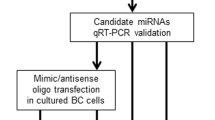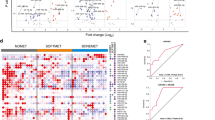Abstract
Caloric restriction (CR) has been shown to cause tumor regression in models of triple-negative breast cancer (TNBC), and the regression is augmented when coupled with ionizing radiation (IR). In this study, we sought to determine if the molecular interaction between CR and IR could be mediated by microRNA (miR). miR arrays revealed 3 miRs in the miR-17~92 cluster as most significantly down regulated when CR is combined with IR. In vivo, CR and IR down regulated miR-17/20 in 2 TNBC models. To elucidate the mechanism by which this cluster regulates the response to CR, cDNA arrays were performed and the top 5 statistically significant gene ontology terms with high fold changes were all associated with extracellular matrix (ECM) and metastases. In silico analysis revealed 4 potential targets of the miR-17~92 cluster related to ECM: collagen 4 alpha 3, laminin alpha 3, and metallopeptidase inhibitors 2 and 3, which were confirmed by luciferase assays. The overexpression or silencing of miR-17/20a demonstrated that those miRs directly affected the ECM proteins. Furthermore, we found that CR-mediated inhibition of miR-17/20a can regulate the expression of ECM proteins. Functionally, we demonstrate that CR decreases the metastatic potential of cells which further demonstrates the importance of the ECM. In conclusion, CR can be used as a potential treatment for cancer because it may alter many molecular targets concurrently and decrease metastatic potential for TNBC.




Similar content being viewed by others
Abbreviations
- TNBC:
-
Triple-negative breast cancer
- CR:
-
Caloric restriction
- IR:
-
Radiation
- ECM:
-
Extracellular matrix
- miR:
-
microRNA
- COL4A3:
-
Collagen 4 alpha 3
- LAMA3:
-
Laminin alpha 3
- TIMP2 and 3:
-
Metallopeptidase inhibitors 2 and 3
References
Dent R, Trudeau M, Pritchard KI, Hanna WM, Kahn HK, Sawka CA, Lickley LA, Rawlinson E, Sun P, Narod SA (2007) Triple-negative breast cancer: clinical features and patterns of recurrence. Clin Cancer Res 13(15):4429–4434. doi:10.1158/1078-0432.ccr-06-3045
Hernandez-Aya LF, Chavez-MacGregor M, Lei X, Meric-Bernstam F, Buchholz TA, Hsu L, Sahin AA, Do K-A, Valero V, Hortobagyi GN, Gonzalez-Angulo AM (2011) Nodal status and clinical outcomes in a large cohort of patients with triple-negative breast cancer. J Clin Oncol 29(19):2628–2634. doi:10.1200/jco.2010.32.1877
Foulkes WD, Smith IE, Reis-Filho JS (2010) Triple-negative breast cancer. N Engl J Med 363(20):1938–1948. doi:10.1056/NEJMra1001389
Pogoda K, Niwińska A, Murawska M, Pieńkowski T (2013) Analysis of pattern, time and risk factors influencing recurrence in triple-negative breast cancer patients. Med Oncol 30(1):1–8. doi:10.1007/s12032-012-0388-4
Montagna E, Maisonneuve P, Rotmensz N, Cancello G, Iorfida M, Balduzzi A, Galimberti V, Veronesi P, Luini A, Pruneri G, Bottiglieri L, Mastropasqua MG, Goldhirsch A, Viale G, Colleoni M (2013) Heterogeneity of triple-negative breast cancer: histologic subtyping to inform the outcome. Clin Breast Cancer 13(1):31–39. doi:10.1016/j.clbc.2012.09.002
Fujita T, Mizukami T, Okawara T, Inoue K, Fujimori M (2013) Identification of a novel inhibitor of triple-negative breast cancer cell growth by screening of a small-molecule library. Breast Cancer 1–10. doi:10.1007/s12282-013-0452-8
Metzger-Filho O, Tutt A, de Azambuja E, Saini KS, Viale G, Loi S, Bradbury I, Bliss JM, Azim HA, Ellis P, Di Leo A, Baselga J, Sotiriou C, Piccart-Gebhart M (2012) Dissecting the heterogeneity of triple-negative breast cancer. J Clin Oncol 30(15):1879–1887. doi:10.1200/jco.2011.38.2010
Duncan James S, Whittle Martin C, Nakamura K, Abell Amy N, Midland Alicia A, ZawistowskiJon S, Johnson Nancy L, Granger Deborah A, Jordan Nicole V, Darr David B, Usary J, Kuan P-F, Smalley David M, Major B, He X, Hoadley Katherine A, Zhou B, Sharpless Norman E, Perou Charles M, Kim William Y, Gomez Shawn M, Chen X, Jin J, Frye Stephen V, Earp HS, Graves Lee M, Johnson Gary L (2012) Dynamic reprogramming of the kinome in response to targeted mek inhibition in triple-negative breast cancer. Cell 149(2):307–321. doi:10.1016/j.cell.2012.02.053
Yunokawa M, Koizumi F, Kitamura Y, Katanasaka Y, Okamoto N, Kodaira M, Yonemori K, Shimizu C, Ando M, Masutomi K, Yoshida T, Fujiwara Y, Tamura K (2012) Efficacy of everolimus, a novel mTOR inhibitor, against basal-like triple-negative breast cancer cells. Cancer Sci 103(9):1665–1671. doi:10.1111/j.1349-7006.2012.02359.x
Song H, Hedayati M, Hobbs RF, Shao C, Bruchertseifer F, Morgenstern A, DeWeese TL, Sgouros G (2013) Targeting aberrant DNA double strand break repair in triple negative breast cancer with alpha particle emitter radiolabeled anti-EGFR antibody. Mol Cancer Ther. doi:10.1158/1535-7163.mct-13-0108
Ibrahim YH, García-García C, Serra V, He L, Torres-Lockhart K, Prat A, Anton P, Cozar P, Guzmán M, Grueso J, Rodríguez O, Calvo MT, Aura C, Díez O, Rubio IT, Pérez J, Rodón J, Cortés J, Ellisen LW, Scaltriti M, Baselga J (2012) PI3 K Inhibition Impairs BRCA1/2 Expression And Sensitizes BRCA-proficient triple-negative breast cancer to PARP inhibition. Cancer Discov 2(11):1036–1047. doi:10.1158/2159-8290.cd-11-0348
Al-Ejeh F, Shi W, Miranda M, Simpson PT, Vargas AC, Song S, Wiegmans AP, Swarbrick A, Welm AL, Brown MP, Chenevix-Trench G, Lakhani SR, Khanna KK (2013) Treatment of triple-negative breast cancer using anti-EGFR–directed radioimmunotherapy combined with radiosensitizing chemotherapy and PARP inhibitor. J Nucl Med 54(6):913–921. doi:10.2967/jnumed.112.111534
De Lorenzo MS, Baljinnyam E, Vatner DE, Abarzúa P, Vatner SF, Rabson AB (2011) Caloric restriction reduces growth of mammary tumors and metastases. Carcinogenesis 32(9):1381–1387. doi:10.1093/carcin/bgr107
Phoenix K, Vumbaca F, Fox M, Evans R, Claffey K (2010) Dietary energy availability affects primary and metastatic breast cancer and metformin efficacy. Breast Cancer Res Treat 123(2):333–344. doi:10.1007/s10549-009-0647-z
Colman RJ, Anderson RM, Johnson SC, Kastman EK, Kosmatka KJ, Beasley TM, Allison DB, Cruzen C, Simmons HA, Kemnitz JW, Weindruch R (2009) Caloric restriction delays disease onset and mortality in rhesus monkeys. Science 325(5937):201–204. doi:10.1126/science.1173635
Blagosklonny MV (2010) Calorie restriction: decelerating mTOR-driven aging from cells to organisms (including humans). Cell Cycle 9(4):683–688
Saleh AD, Simone BA, Palazzo J, Savage JE, Sano Y, Dan T, Jin L, Champ CE, Zhao S, Lim M, Sotgia F, Camphausen K, Pestell RG, Mitchell JB, Lisanti MP, Simone NL (2013) Caloric restriction augments radiation efficacy in breast cancer. Cell Cycle 12(12):8
Zambon AC, Gaj S, Ho I, Hanspers K, Vranizan K, Evelo CT, Conklin BR, Pico AR, Salomonis N (2012) GO-Elite: a flexible solution for pathway and ontology over-representation. Bioinformatics 28(16):2209–2210. doi:10.1093/bioinformatics/bts366
Reiner A, Yekutieli D, Benjamini Y (2003) Identifying differentially expressed genes using false discovery rate controlling procedures. Bioinformatics 19(3):368–375. doi:10.1093/bioinformatics/btf877
Farazi TA, Horlings HM, ten Hoeve JJ, Mihailovic A, Halfwerk H, Morozov P, Brown M, Hafner M, Reyal F, van Kouwenhove M, Kreike B, Sie D, Hovestadt V, Wessels LFA, van de Vijver MJ, Tuschl T (2011) MicroRNA sequence and expression analysis in breast tumors by deep sequencing. Cancer Res 71(13):4443–4453. doi:10.1158/0008-5472.can-11-0608
Dews M, Homayouni A, Yu D, Murphy D, Sevignani C, Wentzel E, Furth EE, Lee WM, Enders GH, Mendell JT, Thomas-Tikhonenko A (2006) Augmentation of tumor angiogenesis by a Myc-activated microRNA cluster. Nat Genet 38(9):1060–1065. http://www.nature.com/ng/journal/v38/n9/suppinfo/ng1855_S1.html
Volinia S, Galasso M, Sana ME, Wise TF, Palatini J, Huebner K, Croce CM (2012) Breast cancer signatures for invasiveness and prognosis defined by deep sequencing of microRNA. Proc Natl Acad Sci 109(8):3024–3029. doi:10.1073/pnas.1200010109
Volinia S, Calin GA, Liu C-G, Ambs S, Cimmino A, Petrocca F, Visone R, Iorio M, Roldo C, Ferracin M, Prueitt RL, Yanaihara N, Lanza G, Scarpa A, Vecchione A, Negrini M, Harris CC, Croce CM (2006) A microRNA expression signature of human solid tumors defines cancer gene targets. Proc Natl Acad Sci USA 103(7):2257–2261. doi:10.1073/pnas.0510565103
Mendell JT (2008) miRiad roles for the miR-17–92 cluster in development and disease. Cell 133(2):217–222. doi:10.1016/j.cell.2008.04.001
O’Donnell KA, Wentzel EA, Zeller KI, Dang CV, Mendell JT (2005) c-Myc-regulated microRNAs modulate E2F1 expression. Nature 435(7043):839–843. http://www.nature.com/nature/journal/v435/n7043/suppinfo/nature03677_S1.html
Ivanovska I, Ball AS, Diaz RL, Magnus JF, Kibukawa M, Schelter JM, Kobayashi SV, Lim L, Burchard J, Jackson AL, Linsley PS, Cleary MA (2008) MicroRNAs in the miR-106b family regulate p21/CDKN1A and promote cell cycle progression. Mol Cell Biol 28(7):2167–2174. doi:10.1128/mcb.01977-07
Molitoris JK, McColl KS, Distelhorst CW (2011) Glucocorticoid-mediated repression of the oncogenic microRNA cluster miR-17–92 contributes to the induction of bim and initiation of apoptosis. Mol Endocrinol 25(3):409–420. doi:10.1210/me.2010-0402
Cascione L, Gasparini P, Lovat F, Carasi S, Pulvirenti A, Ferro A, Alder H, He G, Vecchione A, Croce CM, Shapiro CL, Huebner K (2013) Integrated MicroRNA and mRNA signatures associated with survival in triple negative breast cancer. PLoS One 8(2):e55910. doi:10.1371/journal.pone.0055910
John-Aryankalayil M, Palayoor ST, Makinde AY, Cerna D, Simone CB 2nd, Falduto MT, Magnuson SR, Coleman CN (2012) Fractionated radiation alters oncomir and tumor suppressor miRNAs in human prostate cancer cells. Radiat Res 178(3):105–117
Zhang X, Yu H, Lou JR, Zheng J, Zhu H, Popescu N-I, Lupu F, Lind SE, Ding W-Q (2011) MicroRNA-19 (miR-19) regulates tissue factor expression in breast cancer cells. J Biol Chem 286(2):1429–1435. doi:10.1074/jbc.M110.146530
Dews M, Fox JL, Hultine S, Sundaram P, Wang W, Liu YY, Furth E, Enders GH, El-Deiry W, Schelter JM, Cleary MA, Thomas-Tikhonenko A (2010) The myc–miR-17–92 axis blunts TGFβ signaling and production of multiple TGFβ-dependent antiangiogenic factors. Cancer Res 70(20):8233–8246. doi:10.1158/0008-5472.can-10-2412
Curran CS, Keely PJ (2013) Breast tumor and stromal cell responses to TGF-β and hypoxia in matrix deposition. Matrix Biol 32(2):95–105. doi:10.1016/j.matbio.2012.11.016
DeClerck YA, Mercurio AM, Stack MS, Chapman HA, Zutter MM, Muschel RJ, Raz A, Matrisian LM, Sloane BF, Noel A, Hendrix MJ, Coussens L, Padarathsingh M (2004) Proteases, extracellular matrix, and cancer: a workshop of the path B study section. Am J Pathol 164(4):1131–1139. doi:10.1016/S0002-9440(10)63200-2
Carey L, Winer E, Viale G, Cameron D, Gianni L (2010) Triple-negative breast cancer: disease entity or title of convenience? Nat Rev Clin Oncol 7(12):683–692. http://www.nature.com/nrclinonc/journal/v7/n12/suppinfo/nrclinonc.2010.154_S1.html
Lee C, Raffaghello L, Brandhorst S, Safdie FM, Bianchi G, Martin-Montalvo A, Pistoia V, Wei M, Hwang S, Merlino A, Emionite L, de Cabo R, Longo VD (2012) Fasting cycles retard growth of tumors and sensitize a range of cancer cell types to chemotherapy. Sci Transl Med 4(124):124ra127. doi:10.1126/scitranslmed.3003293
Lee C, Safdie FM, Raffaghello L, Wei M, Madia F, Parrella E, Hwang D, Cohen P, Bianchi G, Longo VD (2010) Reduced levels of IGF-I mediate differential protection of normal and cancer cells in response to fasting and improve chemotherapeutic index. Cancer Res 70(4):1564–1572. doi:10.1158/0008-5472.can-09-3228
Longo VD, Ellerby LM, Bredesen DE, Valentine JS, Gralla EB (1997) Human Bcl-2 reverses survival defects in yeast lacking superoxide dismutase and delays death of wild-type yeast. J Cell Biol 137(7):1581–1588. doi:10.1083/jcb.137.7.1581
Wei M, Fabrizio P, Hu J, Ge H, Cheng C, Li L, Longo VD (2008) Life span extension by calorie restriction depends on Rim15 and transcription factors downstream of Ras/PKA, Tor, and Sch9. PLoS Genet 4(1):e13. doi:10.1371/journal.pgen.0040013
Acknowledgments
The study was funded by the NCI Cancer Center Support Grant P30-CA56036 for the Kimmel Cancer Center.
Conflict of interest
The authors declare that they have no conflict of interest.
Author information
Authors and Affiliations
Corresponding author
Rights and permissions
About this article
Cite this article
Jin, L., Lim, M., Zhao, S. et al. The metastatic potential of triple-negative breast cancer is decreased via caloric restriction-mediated reduction of the miR-17~92 cluster. Breast Cancer Res Treat 146, 41–50 (2014). https://doi.org/10.1007/s10549-014-2978-7
Received:
Accepted:
Published:
Issue Date:
DOI: https://doi.org/10.1007/s10549-014-2978-7




